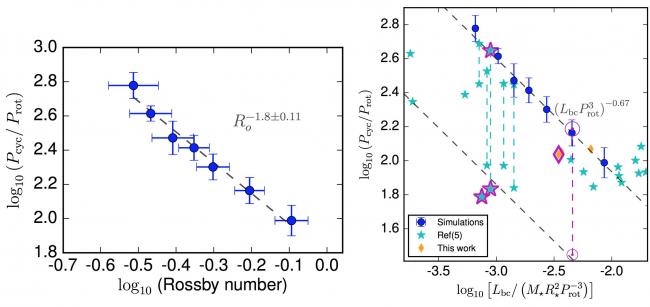Thanks to new numerical simulations, a scientific team led by researchers from the Astrophysics Department-Laboratory AIM of CEA-Irfu has succeeded in explaining why the magnetic field of the Sun reverses every 11 years. Scientists have highlighted the existence of a strong feedback between the star magnetic field and its internal rotation profile, with temporal modulations that ultimately determine the period of the cycle. This major discovery in the understanding of the origin of the star magnetic fields is published on July 14, 2017 in the journal Science.
See the video :  The magnetic cycle of the Sun in virtual reality (CEA Astrophysics)
The magnetic cycle of the Sun in virtual reality (CEA Astrophysics)
An international collaboration including the CEA, the CNRS and the Paris Diderot University simulated the stars' interior in 3D in order to explain the magnetic cyclicity of the stars. Indeed, the Sun has a magnetic field that changes sign (reverses) every 11 years for several centuries. It is the source of highly energetic eruptive phenomena that can impact our Earth. This magnetic field is produced by the turbulent convective movements that animate the interior of our star via a dynamo effect [1]. Magnetic cycles are also observed on other solar-type stars, with typical periodicities from one year to a few decades.
The magnetic field of a star is generated by the moving conductive fluid which constructs it by dynamo effect. In the Sun, this fluid includes at the same time:
- large-scale flows (a differential rotation in radius and latitude, and a circulation in the meridional plane),
- and a multi-scale turbulent flow resulting from the instability of convection that operates in the outer spherical shell of our star (from 0.7 solar radius to the surface).
These two types of flows play an essential role in self-sustaining a large-scale global magnetic field. In some cases, as for the Sun, this global magnetic field oscillates over a decennial period by a mechanism that still remains poorly understood today.

Simulation of the azimuthal magnetic field, as a function of latitude and time. It is observed that the magnetic field reverses regularly and oscillates between symmetrical phases (same sign on both sides of the equator for example between 100 and 140 years) and antisymmetric (opposite sign for example between 240 and 320 years) with respect to the equator. © DAp-CEA/Montreal University
The magnetic field of a star draws its energy from the flows of matter which animate its interior. Thanks to their simulations, the researchers have shown that the rotation of the star influences the efficiency of the transfer of energy between these turbulent flows and the magnetic field. The same phenomenon also determines the cycle period, which has been now shown to decrease with the Roosby number [2], a dimensionless number widely used in geophysical fluid dynamics that measures the effects of centrifugal forces.
The discovery of such a scaling law for the period of the star magnetic cycle from self-consistent turbulent 3D simulations is a world first. Thanks to different observation programs, researchers now have information about the duration of magnetic cycles of solar-type stars, for which they often know the luminosity with good precision. By considering their rotation characteristics, researchers can also now deduce the properties of their magnetic cycle. By observing more and more stars, and thanks to new numerical simulations that will vary the internal structure of the star, astrophysicists hope to refine this new scenario of the origin of the stellar magnetic cycles.

Left: Relationship between the ratio of the magnetic cycle period and the star rotation period as a function of the Rossby number in turbulent 3D simulations. A power law decreasing with the Rossby number is observed due to the strong non-linearity of the dynamo effect in these simulations. To the right; The same ratio as a function of the normalized luminosity of the star. The blue dots are the results of the simulations compared to the characteristics of the Sun (purple circle with a dot at its center) and stars of solar type (cyan stars and orange diamonds). The vertical dashed lines correspond to stars for which two types of magnetic periodicities have been identified. ©DAp-CEA/Montreal University
The scientists have thus demonstrated the existence of a strong feedback between the magnetic field of the star and its internal rotation profile, whose temporal modulations ultimately determine the period of the cycle. These results take advantage of the major GENCI, PRACE and ComputeCanada computers. They provide a new theoretical interpretation of stellar magnetic cycles, and place the Sun as the cornerstone of our understanding of the dynamics of stars. By characterizing the magnetism of solar type stars, these simulations will make it possible in particular to prepare the scientific return of the next European missions Solar Orbiter and PLATO.
Contacts : A. Strugarek, A.S. Brun
Publication:
"Reconciling solar and stellar magnetic cycles with nonlinear dynamo simulations".
Strugarek A., Beaudoin P., Charbonneau P., Brun A.S., Do Nascimento Jr. J.
Published in Science, 14 July 2017
See: - the CEA-CNRS press release (July 14, 2017)
See also: Stellar magnetic winds (January 19, 2017) (in French)
A way to test magnetic field generation inside stars and planets (May 23, 2017)
[1] The dynamo effect corresponds to the spontaneous generation of a magnetic field within a moving conductive liquid.
[2] The Rossby number measures the ratio of the inertia forces to the Coriolis force applied to a fluid in a rotating reference frame. A small number of Rossby corresponds to a situation where the effect of rotation (Coriolis) dominates fluid movements, as in the case, for example, of the global circulation of oceanic air masses on Earth.
Content : A. Strugarek, CEA Com, J.M. Bonnet-Bidaud
• Structure and evolution of celestial bodies
• Institute of Research into the Fundamental Laws of the Universe • Department of Astrophysics (DAp) // UMR AIM
• Dynamics of Stars, Exoplanets and their Environment
• PLATO • Solar Orbiter
